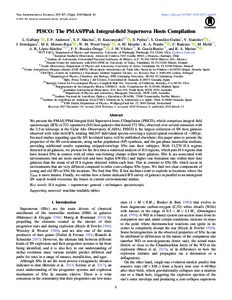PISCO: The PMAS/PPak Integral-field Supernova Hosts Compilation
L. Galbany; J. P. Anderson; S. F. Sánchez; H. Kuncarayakti; S. Pedraz; S. González-Gaitán; V. Stanishev; I. Domínguez; M. E. Moreno-Raya; W. M. Wood-Vasey; A. M. Mourão; K. A. Ponder; C. Badenes; M. Mollá; A. R. López-Sánchez; F. F. Rosales-Ortega; J. M. Vílchez; R. García-Benito; R. A. Marino
PISCO: The PMAS/PPak Integral-field Supernova Hosts Compilation
L. Galbany
J. P. Anderson
S. F. Sánchez
H. Kuncarayakti
S. Pedraz
S. González-Gaitán
V. Stanishev
I. Domínguez
M. E. Moreno-Raya
W. M. Wood-Vasey
A. M. Mourão
K. A. Ponder
C. Badenes
M. Mollá
A. R. López-Sánchez
F. F. Rosales-Ortega
J. M. Vílchez
R. García-Benito
R. A. Marino
IOP PUBLISHING LTD
Julkaisun pysyvä osoite on:
https://urn.fi/URN:NBN:fi-fe2021042718926
https://urn.fi/URN:NBN:fi-fe2021042718926
Tiivistelmä
We present the PMAS/PPak Integral-field Supernova hosts COmpilation (PISCO), which comprises integral field spectroscopy (IFS) of 232 supernova (SN) host galaxies that hosted 272 SNe, observed over several semesters with the 3.5 m telescope at the Calar Alto Observatory (CAHA). PISCO is the largest collection of SN host galaxies observed with wide-field IFS, totaling 466,347 individual spectra covering a typical spatial resolution of similar to 380 pc. Focused studies regarding specific SN Ia-related topics will be published elsewhere; this paper aims to present the properties of the SN environments, using stellar population (SP) synthesis, and the gas-phase interstellar medium, providing additional results separating stripped-envelope SNe into their subtypes. With 11,270 H ii regions detected in all galaxies, we present for the first time a statistical analysis of H ii regions, which puts H ii regions that have hosted SNe in context with all other star-forming clumps within their galaxies. SNe Ic are associated with environments that are more metal-rich and have higher EW(H alpha) and higher star formation rate within their host galaxies than the mean of all H ii regions detected within each host. This in contrast to SNe IIb, which occur in environments that are very different compared to other core-collapse SNe types. We find two clear components of young and old SPs at SNe IIn locations. We find that SNe II fast decliners tend to explode at locations where the Sigma(SFR) is more intense. Finally, we outline how a future dedicated IFS survey of galaxies in parallel to an untargeted SN search would overcome the biases in current environmental studies.
Kokoelmat
- Rinnakkaistallenteet [27094]
